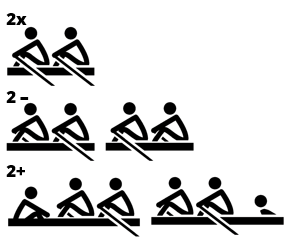|
|
Rowing dictionary – P |
Pair (2-) or (2+)
Boat with two sweep rowers. The Coxless pair (2-), often called a straight pair, is a demanding but satisfying boat to master. Coxed pairs (2+) are rarely rowed by most club and school programs. It is no longer an Olympic class event, but it continues to be rowed at the World Rowing Championships.

Also see:  Discipline.
Discipline.
Pause paddling
Exercise in which the recovery is briefly interrupted (pause) during the recovery. The coxswain or rower giving commands will indicate where in the recovery this pause should be taken. Main article:  Pause paddling (easy all).
Pause paddling (easy all).
Pausing before the catch
Mistake, waiting a while before making the catch. Main article:  Pausing before the catch.
Pausing before the catch.
Piece
A specified distance with a particular goal. Pieces are usually acknowledged by the coach: "We will do a piece".
Pimenov draw
Exercise that involves rowing only with the legs. Main article:  Pimenov draw (legs only).
Pimenov draw (legs only).
Pin
The vertical metal rod (spindle) on which the oarlock rotates
Pitch (boat)
The rising and falling of the bow and stern due to mass displacement of the rowers
Pocock
American supplier of boats.
Pogies
A type of glove covering the handle as well as the hand holding the handle. These allow the rower to grip the oar while also warming the hands.
Points
Points are awarded to rowers for winning races. Number of points determines the status of the rower.
Port or portside
Also see:  Strokeside.
Strokeside.
Position length
Rigging element that gives the distance between the front of two successive foot stretcher channels. Main article:  Position length.
Position length.
Pot
Achieve (win) 1st place in a competition with corresponding medal (a pot).
Power house
See:  Engine room.
Engine room.
Power phase
See:  Draw.
Draw.
Power variation
Conditional exercise where the pressure is varied. Main article:  Power variation.
Power variation.
Practice draw sequence
Exercise in which the draw is extended further and further, starting at the catch. Main article:  Practice draw sequence.
Practice draw sequence.
Practice pressure build-up
Exercise on the  Rowing machine to learn to catch the water quick and efficient. Main article:
Rowing machine to learn to catch the water quick and efficient. Main article:  Practice pressure build-up.
Practice pressure build-up.
Dynamic lengthening
Exercise in which rowers are successively rowing with arms only, with ¼ seat and with full stroke. Main article:  Dynamic lengthening.
Dynamic lengthening.
Preferred rowing stroke
The advised rowing stroke of the Rowing coach foundation.
Pressure
The amount of effort applied by the rower to the power phase of the stroke (usually light, ½, ¾, firm or full).
Pressure build-up
Rapidly building up the pressure that the blade exerts on the water after the catch. Main article:  Catch.
Catch.
Pressureless end draw
Mistake where the blade no longer provides propulsion during the last part of the draw. Main article:  Pressureless end draw.
Pressureless end draw.
Pre-start
Place where at a running start, building up speed is started, so that the boat goes through the start at full speed.
Prioritise
Second step in correcting rowing mistakes, determining the mistake that must be addressed first. Main article:  Prioritise.
Prioritise.
Puddles
Disturbances made by an oar blade pulled through the water. The farther the puddles are pushed past the stern of the boat before each catch, the more “run” the boat is getting.
Pull the trunk over the handle(s)
Mistake where the trunk becomes more horizontal during the last part of the draw, where the arms are pulling. Main article:  Pull the trunk over the handle(s).
Pull the trunk over the handle(s).
Pull through
See:  Draw.
Draw.
Pulling up the shoulders
Mistake where the shoulders are moved up and down, instead of forth and back. Main article:  Pulling up the shoulders.
Pulling up the shoulders.
Pyramid training
Conditional exercise where the duration of the high pressure strokes is made shorter and the longer again. Main article:  Doing pyramids.
Doing pyramids.
 |
Rowing dictionary – O |
 |
Rowing dictionary – R |
This article was translated automatically and is provided to you for free. You are most welcome to improve it!











